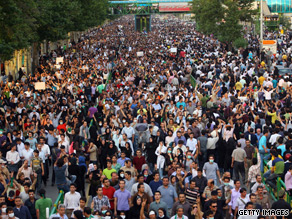Iranian forces disperse protesters with batons, tear gas
- Story Highlights
- July 9 marks 10th anniversary of turning point in Iranian reformist movement
- Massive protests rocked Iran in the days following the June 12 election
- Supporters of opposition candidates questioned the legitimacy of the vote
- IRNA: Police chief urges citizens of Tehran to consider leaving
TEHRAN, Iran (CNN) -- Iranian pro-government Basij militia members dispersed crowds of protesters here Thursday -- sometimes with force -- witnesses said.

Protests by Iranians, such as this one on June 15, have been defended by the reformist figures.
An estimated 2,000 to 3,000 people crowded the streets in different locations of the city, and headed toward Tehran University, the site of a student uprising in 1999. Several protesters were hit on the arms and backs by the Basij, pro-government militia members, while elsewhere riot police released tear gas into crowds.
Iran's state-funded Press TV described the crowd size near the university in the hundreds.
Some of the protesters shouted "Allah u Akbar," or "God is Great" and "Ya Hussein, Mir Hussein" referring to opposition candidate Mir Hossein Moussavi, the witnesses said. Police blocked roads leading to Tehran University, while some protesters set trash cans afire so smoke would counter the effects of the tear gas.
When crowds tried to gather between 4 p.m. and 5 p.m. in Revolution Square, hundreds of security forces were waiting for them, witnesses told CNN. ![]() Watch scenes of protesters and street clashes »
Watch scenes of protesters and street clashes »
Most of the security forces were uniformed officers wearing helmets and holding batons and shields, though many wore plain clothes. The forces ordered bystanders to move along, the witnesses said.
There were at least five reports of clashes during this time.
Over the next two hours, the crowds grew to around 3,000, but witnesses said security forces grew too.
Don't Miss
Many of the protesters left Revolution Square and marched to side streets and neighborhoods a few kilometers away.
Many held up victory signs and clapped. The contents of several Dumpsters were set afire. See the protests and violence through Iranians' own photos
Witnesses said they heard several pops that sounded like gunshots and saw security forces fire what appeared to be pepper spray towards the crowds on several occasions.
Some of the chants heard Thursday were familiar refrains that have been repeated often in recent days:
"Death to the Dictator!"
"Death to Khamenei!"
But a new phrase entered the lexicon on Thursday that referred to Mojtaba, the son of Supreme Leader Ayatollah Khamanei: "Mojtaba bemire, rahbariroh nagiri," they chanted: "Die, Mojtaba, so you don't become the supreme leader!"
During the past week, rumors have surfaced that Mojtaba has taken over the pro-government Basij militia and that his father is grooming him to be the next supreme leader. Thursday marked the first time protesters chanted against him.
By nightfall, most of the demonstrators headed home.
At 10 p.m. Tehran time two sources told CNN the chants of "God is great!" were louder than usual in their neighborhoods.
The demonstration took place on the 10th anniversary of a student uprising that posed a major threat to the Islamic regime. On Thursday, the protesters used the anniversary to resume demonstrations against the outcome of the contested June 12 presidential election.
Iranian-American journalist Jason Rezaian said Iranians have been scared since last month's bloody crackdown on those who protested the accuracy of election results. Incumbent Mahmoud Ahmadinejad was declared the winner by a landslide over reformist candidate Moussavi, his chief rival, who declared the election rigged.
Moussavi's supporters took to the streets by the thousands in the aftermath of the vote until the protests turned bloody as security forces cracked down. Iranian state-run media said 20 people have been killed and more than 1,000 have been detained.

On July 9, 1999, known in the Iranian calendar as the 18th of Tir, 200 students protested the closing of a reformist newspaper, Salaam, which supported moderate President Mohammed Khatami. Hard-line activists entered dormitories in Tehran University, broke windows, set fires and attacked students.
Six days of protests ensued. According to Human Rights Watch, more than 25,000 people participated, making the demonstrations the biggest threat to the Islamic regime since its inception in 1979.
CNN's CNN's Reza Sayah and Moni Basu in Atlanta, Georgia, contributed to this report.
All About Iran • Ayatollah Ali Khamenei

 Sit tight, we're getting to the good stuff
Sit tight, we're getting to the good stuff